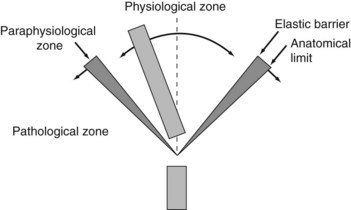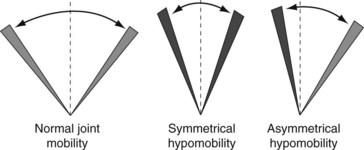Chapter 93Chiropractic Evaluation and Management of Musculoskeletal Disorders
Manual Therapy and Chiropractic
Joint mobilization and manipulation are two types of induced articular movements used in musculoskeletal rehabilitation to restore joint function. Mobilization is characterized as repetitive joint movements induced within the normal physiological range of joint motion (Figure 93-1). Joint manipulation (e.g., chiropractic adjustment) occurs within the paraphysiological zone, which lies outside of the active (i.e., patient induced) and passive ranges of joint motion. In people, joint mobilization and manipulation induce different physiological responses. Manipulation in people relieved adjacent spontaneous myoelectrical activity immediately, whereas mobilization did not.2
History of Equine Chiropractic
Chiropractors often have been asked to treat the horses of clients who have experienced the benefits of chiropractic care for their own back or neck problems. Horse owners often want the opportunity to have the same type of care for their horses, without the potential adverse effects of medications or surgery. The recent increased awareness of the prevalence and management options to address back problems with which traditional veterinary medicine has had difficulty in dealing has also stimulated horse owners’ interest in complementary forms of treatment.5 Any vertebral column disorder can have serious effects on a horse’s ability to perform. Back problems can be classified into three basic types of injuries—those involving the muscles, tendons, and ligaments (soft tissue injuries); bones and joints (osseous injuries); or nervous system (neurological disorders). However, several concurrent injuries have been reported in 17% of horses with back pain.6 Diagnosis of the underlying vertebral pathological conditions in horses with back pain is important for the appropriate treatment and management of these disorders (see Chapter 52).





